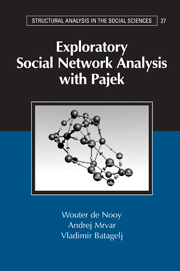Book contents
- Frontmatter
- Contents
- List of Illustrations
- List of Tables
- Preface
- Part I Fundamentals
- Part II Cohesion
- Part III Brokerage
- Part IV Ranking
- 9 Prestige
- 10 Ranking
- 11 Genealogies and Citations
- Part V Roles
- Appendix 1 Getting Started with Pajek
- Appendix 2 Exporting Visualizations
- Appendix 3 Shortcut Key Combinations
- Glossary
- Index of Pajek Commands
- Subject Index
11 - Genealogies and Citations
Published online by Cambridge University Press: 05 June 2012
- Frontmatter
- Contents
- List of Illustrations
- List of Tables
- Preface
- Part I Fundamentals
- Part II Cohesion
- Part III Brokerage
- Part IV Ranking
- 9 Prestige
- 10 Ranking
- 11 Genealogies and Citations
- Part V Roles
- Appendix 1 Getting Started with Pajek
- Appendix 2 Exporting Visualizations
- Appendix 3 Shortcut Key Combinations
- Glossary
- Index of Pajek Commands
- Subject Index
Summary
Introduction
Time is responsible for a special kind of asymmetry in social relations, because it orders events and generations in an irreversible way. Social identity and position is partially founded on common ancestors, whether in a biological sense (birth) or in an intellectual manner: citations by scientists or references to predecessors by artists. This is social cohesion by common descent, which is slightly different from cohesion by direct ties (see Part II). Social communities and intellectual traditions can be defined by a common set of ancestors, by structural relinking (families which intermarry repeatedly), or by long-lasting cocitation of papers.
Pedigree is also important for the retrospective attribution of prestige to ancestors. For example, in citation analysis the number of descendants (citations) is used to assign importance and influence to precursors. Genealogy is the basic frame of reference here, so we discuss the analysis of genealogies first.
Example I: Genealogy of the Ragusan Nobility
Ragusa, which is now known as Dubrovnik (Croatia), was settled on the coast of the Adriatic Sea in the seventh century. For a time, it was under Byzantine protection, becoming a free commune as early as the twelfth century. Napoleon, having destroyed the Venetian Republic in 1797, put an end to the Republic of Ragusa in 1806. It came under Austrian control until the fall of the Austro-Hungarian monarchy in 1918.
- Type
- Chapter
- Information
- Exploratory Social Network Analysis with Pajek , pp. 226 - 256Publisher: Cambridge University PressPrint publication year: 2005



